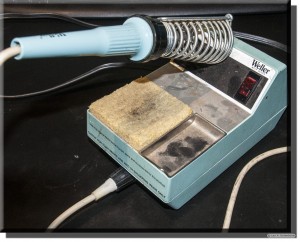 That soldering iron doesn’t really belong to me.
That soldering iron doesn’t really belong to me.
Back in “the day” (1983, to be exact), when I joined Microsoft it was truly a small company. 360 people small.
It was also not networked. Instead, each office was connected to shared servers by one or more RS-232 serial port connections – think dialup modem technology, but with (mostly) faster speeds. The servers were multi-user Xenix systems, or an the older DEC 2020 machine running TOPS-20 (now, itself, a museum piece). Typical use was that after writing and compiling the software in terminal mode we’d switch the serial connection to the PC in our office and download the software for testing.
At 360 people Microsoft also didn’t really have an IT department. In many ways like most start-ups it kinda was an IT department unto itself, with everyone mostly responsible for everything to varying degrees. It wasn’t unusual to have to head to the machine room to reboot whichever server had most recently crashed – particularly after hours or on weekends when you might be the only, or perhaps just the first, person to notice.
A more practical result was that it also meant is that you were responsible for building your own cables. Microsoft might have some parts lying around and a spool of cable here or there, but assembling the parts into a functioning RS-232 serial cable? That was up to you.
Hence the soldering iron. It’s Microsoft’s. In fact, it might have belonged specifically to the group I initially joined, long since reorganized out of existance. I’m sure a company even of that early size probably had more than one soldering iron. But this was the one I got to use.
So, I made cables as needed. After all, my background’s electrical engineering, and I’d done my share of soldering at home (yes, at home), so it wasn’t really that big a deal. I made ’em for some of my co-workers as well. The larger concern was whether the hardware it was to be used on required all 25 wires on the “big” RS-232 connectors (rarely), or could get away with only 9 (often), or perhaps as few as 4 (cheating, but common).
Then came Ethernet. When we moved to the new campus in 1986 our offices included ethernet connections to fancy new PC-based file servers. Many of the old time-share servers that we’d been using until that time didn’t even make the trek.
So it came to pass that whoever had the soldering iron on move day packed it away for the move and brought it along.
Of course that “whoever” was me.
I used it occasionally at first, but over time less and less. Ethernet cables could be ordered, much like almost all the accessories you might expect needed in a larger and growing company. So, I occasionally borrowed it for things at home, and naturally one day it seemed like it didn’t make the trip back into work.
Fast forward to November of 2001, when I left Microsoft.
I seriously thought about returning it. Honest.
But there was no one to give it back to. It had outlasted its corporate utility.
So, here it sits. I broke it out the other day to solder connectors on an antenna cable I was running for my ham radio, and it’s still working well.
I think I’ll hang on to it for a little longer.

I have the model that is previous to this one and it is still going string. I purchased mine in the late 1970s and it has taken a physical beating over the years. I guess I don’t use it much these days but its still handy to have. The temperature control feature that Weller came up with is a beauty.
Did you have a solder sucker, too?
Oh, but of course! Still have that too.
My first network connection at the Jet Propulsion Laboratory wasn’t Ethernet either …but I’m not sure what it was. I vaguely recall a box on the floor that then connected (perhaps via serial) into my computer. But that was quickly replaced by Ethernet …over coax.
As I was leaving, it was announced that the LAN was being upgraded to 10 MBPS per workstation (but if you “needed” more, you could do a justification memo to get 100) — and that was in 1996! Sadly, that went in after I was gone, but I’d STILL like to get 10 MBPS, and I’ll bet you would too!
I still have a brother to that soldering iron in a box in my garage.
When I went to work for H&W Computer Systems in Boise in 1987 they still had an RS-232 connected system. It wasn’t until over a year later, when they sold the software product I had been working on for $2 million, that they put in an Ethernet-connected Novell server.